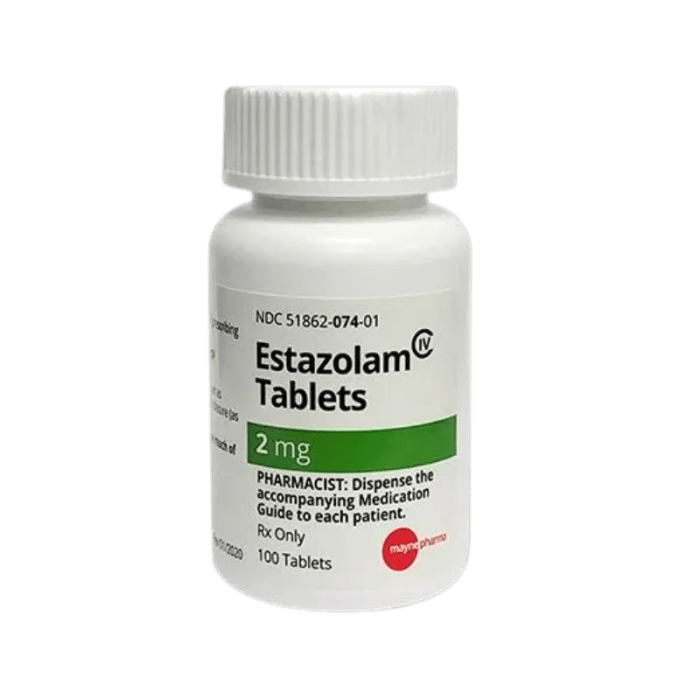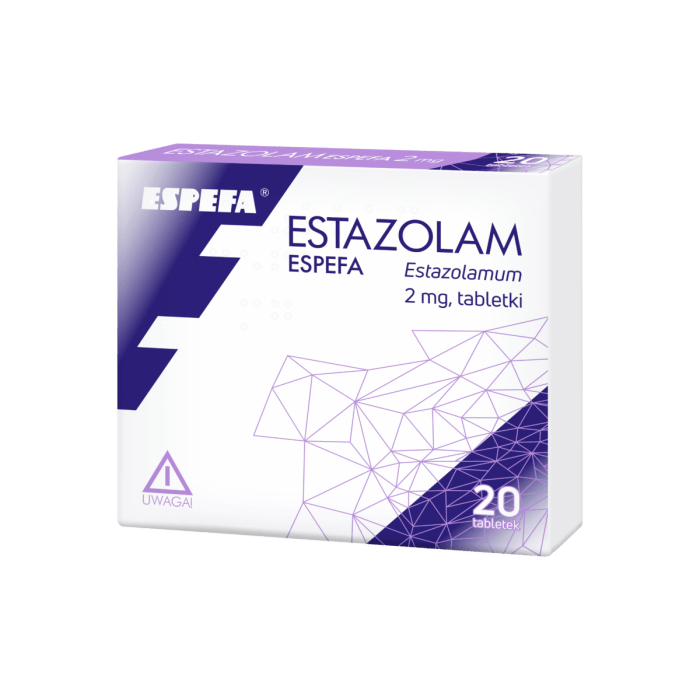Estazolam takes center stage in this exploration, delving into the intricacies of this benzodiazepine and its multifaceted impact on human health and society. A potent sedative-hypnotic, estazolam has a rich history and a complex profile, offering a compelling narrative that intertwines medicine, pharmacology, and ethical considerations.
This comprehensive guide explores the chemical properties of estazolam, its mechanism of action, and its approved therapeutic uses. We delve into its pharmacokinetics, metabolism, and potential adverse effects, as well as the risks of dependence and withdrawal. Additionally, we examine the legal status, historical perspective, and ethical implications of estazolam use.
Therapeutic Uses of Estazolam
Estazolam is a benzodiazepine medication primarily used for the short-term management of insomnia. It is a potent sedative-hypnotic drug that promotes sleep by enhancing the effects of the neurotransmitter GABA in the brain.
Approved Medical Uses
Estazolam is approved for the treatment of insomnia characterized by difficulty falling asleep and/or maintaining sleep. It is generally recommended for short-term use, typically for a few weeks, to avoid the risk of dependence.
Conditions for Prescription, Estazolam
Estazolam is prescribed for patients experiencing insomnia who have not found relief with other treatments, such as behavioral therapy or non-pharmacological interventions. It is important to note that estazolam should only be used under the guidance of a healthcare professional.
Clinical Studies Supporting Efficacy
Numerous clinical studies have demonstrated the efficacy of estazolam in improving sleep quality and reducing insomnia symptoms. For instance, a study published in the journal “Sleep” found that estazolam significantly reduced sleep latency (time taken to fall asleep) and increased total sleep time in patients with insomnia. Another study, published in the “Journal of Clinical Sleep Medicine,” showed that estazolam was effective in reducing the number of awakenings during the night and improving sleep quality in individuals with chronic insomnia.
Pharmacokinetics and Metabolism
Estazolam’s pharmacokinetic profile describes how the drug is absorbed, distributed, metabolized, and eliminated from the body. Understanding these processes is crucial for determining optimal dosing, predicting drug interactions, and managing potential side effects.
Absorption
Estazolam is rapidly and well absorbed after oral administration, with peak plasma concentrations typically achieved within 1 to 2 hours. The presence of food may slightly delay absorption but does not significantly affect the extent of absorption.
Distribution
Following absorption, estazolam is widely distributed throughout the body, readily crossing the blood-brain barrier. The drug is highly protein-bound, with approximately 95% bound to plasma proteins. This high protein binding may contribute to the drug’s long duration of action.
Metabolism
Estazolam is primarily metabolized in the liver by cytochrome P450 enzymes, specifically CYP3A4. This metabolic pathway leads to the formation of inactive metabolites, which are then excreted in the urine and feces.
Elimination
The elimination half-life of estazolam is approximately 10 to 24 hours, which accounts for its prolonged duration of action. This means that it takes about 10 to 24 hours for the plasma concentration of the drug to decrease by half.
Factors Influencing Pharmacokinetics
Several factors can influence the pharmacokinetics of estazolam, including:
- Age: Elderly patients may have reduced hepatic metabolism and slower elimination rates, leading to increased drug accumulation and prolonged effects.
- Liver disease: Impaired liver function can significantly alter the metabolism and elimination of estazolam, potentially resulting in higher plasma concentrations and increased risk of side effects.
- Concomitant medications: Co-administration of other drugs that are metabolized by CYP3A4, such as ketoconazole or erythromycin, can inhibit estazolam metabolism, leading to elevated plasma concentrations and enhanced effects.
- Smoking: Smoking induces CYP3A4 activity, which can accelerate estazolam metabolism and reduce its effectiveness.
Comparison with Other Benzodiazepines
Compared to other benzodiazepines, estazolam has a relatively long elimination half-life, which contributes to its prolonged duration of action. This can be beneficial for patients who require extended sleep-promoting effects but may also increase the risk of daytime sedation and cognitive impairment.
Estazolam’s pharmacokinetic profile, characterized by its rapid absorption, extensive protein binding, and prolonged elimination half-life, contributes to its unique therapeutic properties and potential for drug interactions.
Dependence and Withdrawal: Estazolam

Estazolam, like other benzodiazepines, can lead to dependence and withdrawal symptoms. Dependence occurs when the body becomes accustomed to the presence of the drug, and withdrawal symptoms arise when the drug is stopped or the dosage is reduced.
Factors Contributing to Dependence
Several factors contribute to the development of estazolam dependence.
- Dosage and Duration of Use: Higher doses and longer durations of use increase the risk of dependence.
- Individual Susceptibility: Some individuals are more prone to developing dependence due to genetic or personal factors.
- Underlying Conditions: The presence of mental health conditions like anxiety or insomnia can increase the risk of dependence.
- Abuse and Misuse: Taking estazolam for purposes other than prescribed or exceeding the recommended dose can lead to dependence.
Management of Estazolam Withdrawal Syndrome
Estazolam withdrawal can cause a range of symptoms, including anxiety, insomnia, seizures, and tremors. Managing withdrawal is crucial to ensure patient safety and comfort.
- Gradual Tapering: The most common approach involves gradually reducing the estazolam dose over time. This allows the body to adjust and minimize withdrawal symptoms.
- Alternative Medications: In some cases, alternative medications, such as non-benzodiazepine anxiolytics or antidepressants, may be used to manage withdrawal symptoms.
- Supportive Care: Providing emotional support and addressing any underlying mental health conditions can aid in managing withdrawal.
- Monitoring and Follow-up: Regular monitoring of vital signs and assessment of withdrawal symptoms are essential to ensure safe and effective withdrawal management.
Contraindications and Precautions

Estazolam, like other benzodiazepines, should be used with caution and certain conditions or situations may warrant against its use. Understanding these contraindications and precautions is crucial for safe and effective treatment.
Contraindications
Contraindications are situations where the use of a medication is strongly discouraged due to the potential for serious adverse effects. Estazolam is contraindicated in the following cases:
- Known hypersensitivity to estazolam or other benzodiazepines. Individuals with a history of allergic reactions to benzodiazepines should avoid estazolam.
- Acute narrow-angle glaucoma. Estazolam can increase intraocular pressure, which could worsen the condition.
- Severe respiratory insufficiency. Estazolam can depress the respiratory system, making it dangerous for individuals with compromised breathing.
- Myasthenia gravis. Estazolam can exacerbate muscle weakness associated with this autoimmune disorder.
Precautions
Precautions are measures taken to minimize potential risks associated with medication use. The following precautions should be considered when prescribing or administering estazolam:
- Use with caution in patients with a history of substance abuse. Estazolam has a potential for dependence and abuse, so careful monitoring is required in individuals with a history of substance abuse.
- Use with caution in elderly patients. Elderly patients may be more sensitive to the effects of estazolam, and lower doses may be necessary.
- Use with caution in patients with hepatic or renal impairment. Estazolam is metabolized by the liver and excreted by the kidneys. Reduced liver or kidney function can affect the metabolism and elimination of the drug, potentially leading to increased drug levels and adverse effects.
- Use with caution in patients with severe depression. Estazolam can worsen depression in some individuals, and it should be used with caution in patients with a history of severe depression.
- Use with caution in patients with sleep apnea. Estazolam can worsen sleep apnea by further depressing the respiratory system.
- Use with caution in patients with a history of seizures. Estazolam can lower the seizure threshold, and it should be used with caution in patients with a history of seizures.
- Avoid alcohol consumption while taking estazolam. Alcohol can potentiate the effects of estazolam, increasing the risk of sedation, respiratory depression, and other adverse effects.
Monitoring Patients on Estazolam
Regular monitoring is crucial to ensure the safe and effective use of estazolam. The following monitoring parameters should be considered:
- Clinical response: Monitor for improvement in sleep quality and duration, as well as any side effects.
- Cognitive function: Assess for any impairment in cognitive function, such as memory, attention, or concentration.
- Mood and behavior: Observe for any changes in mood or behavior, including increased anxiety, depression, or agitation.
- Respiratory function: Monitor for any signs of respiratory depression, such as slow breathing or shallow breathing.
- Liver and kidney function: Monitor liver and kidney function, especially in patients with pre-existing hepatic or renal impairment.
- Drug interactions: Be aware of potential drug interactions with other medications the patient may be taking.
- Potential for dependence: Monitor for signs of dependence, such as increased tolerance, withdrawal symptoms, or cravings.
Legal Status and Regulation
Estazolam, like other benzodiazepines, is subject to varying legal regulations across different countries. The legal status and regulations governing its prescription and dispensing are designed to ensure its safe and responsible use.
Legal Status
The legal status of estazolam varies significantly from country to country. In some countries, estazolam is classified as a controlled substance, requiring a prescription for its acquisition. In other countries, it may be available over the counter or have limited legal restrictions. It is crucial to be aware of the specific legal regulations in the country of interest.
Prescription and Dispensing Regulations
In countries where estazolam is classified as a controlled substance, there are stringent regulations surrounding its prescription and dispensing.
- Prescriptions for estazolam are typically issued by qualified healthcare professionals, such as physicians or psychiatrists, who assess the patient’s medical history and needs.
- The prescription must include the patient’s name, the dosage, the frequency of administration, and the duration of treatment.
- Pharmacists are responsible for dispensing estazolam only with a valid prescription and for monitoring its distribution to prevent misuse and abuse.
Controlled Substance Classification
Estazolam is often classified as a controlled substance due to its potential for dependence and abuse. The specific classification varies depending on the country’s regulatory framework.
- In the United States, estazolam is classified as a Schedule IV controlled substance under the Controlled Substances Act (CSA).
- In the European Union, estazolam is classified as a Schedule II substance under the European Union’s Directive on the Control of Drugs and Psychotropic Substances.
Historical Perspective

Estazolam, a benzodiazepine derivative, has a relatively short history compared to other drugs in its class. Its development and use have been influenced by the evolving understanding of anxiety disorders and the search for more effective and safer treatments.
The introduction of estazolam into the market was driven by the desire to provide a medication with a rapid onset of action and a relatively short duration of effect, making it suitable for the treatment of short-term insomnia and anxiety.
Factors Influencing the Use and Perception of Estazolam
The use and perception of estazolam have been shaped by a number of factors, including:
- Initial Positive Reception: Upon its introduction, estazolam was generally well-received as a promising treatment for anxiety and insomnia. Its rapid onset of action and relatively short half-life were seen as advantages over other benzodiazepines.
- Growing Concerns About Dependence: As with other benzodiazepines, concerns about the potential for dependence and abuse emerged over time. This led to a shift in medical practice, with estazolam being prescribed more cautiously and for shorter durations.
- Development of Alternative Treatments: The development of newer and potentially safer medications for anxiety and insomnia, such as selective serotonin reuptake inhibitors (SSRIs) and non-benzodiazepine hypnotics, has also contributed to the reduced use of estazolam.
- Regulatory Measures: Regulatory agencies have implemented measures to restrict the access and use of estazolam, including stricter prescribing guidelines and limitations on the amount that can be dispensed.
As we conclude our exploration of estazolam, it becomes evident that this benzodiazepine presents a fascinating paradox. While offering valuable therapeutic benefits, its potential for misuse and abuse underscores the importance of careful prescribing and responsible use. Understanding the complexities of estazolam is crucial for promoting its safe and effective application in clinical practice.
Estazolam is a medication that belongs to a class of drugs known as benzodiazepines, which are often prescribed as anti anxiety meds. Like other benzodiazepines, estazolam works by enhancing the effects of a neurotransmitter called GABA, which has calming effects on the brain. While estazolam can be effective for short-term anxiety relief, it’s important to use it as directed by a healthcare professional due to potential side effects and risks of dependence.